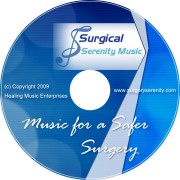Many inventions of the 19th century -- telephones, airplanes, phonographs -- have helped to shape the modern world. However, it could be argued that the 1846 discovery of effective surgical anesthesia holds a place of honor among the century's advances.
Music for Surgery Headphones now available!
Use Less Anesthesia by adding music
Prior to the advent of effective anesthetics, surgery was a desperate last resort that used crude and dangerous means (including large doses of opium or alcohol, or knocking a patient unconscious) to dull the patient's sensations. Today, whether it is a shot of novocaine at the dentist, a spinal or epidural during childbirth, deep sedation for a minor procedure or general anesthesia for major surgery, the use of effective anesthesia is a routine part of medical care.
Although most of us have experienced anesthesia, the general public has little understanding of what it is and how it works. According to Steve Kimatian, associate professor of anesthesiology and pediatrics in Penn State's College of Medicine, anesthesia is not a single entity, but rather a manipulation of several physiological functions of the body.
"In its most basic sense, you can say that anesthesia consists of four components: hypnosis, amnesia, analgesia and muscle relaxation," explained Kimatian.
These components -- which range from local anesthetic injections to regional anesthetics (such as spinal and epidural) to general anesthesia -- may be combined or used separately depending on the type of surgery and patients' needs.
While you may have thought you were "asleep" for that tonsillectomy as a teenager, technically you were in a state of deep hypnosis. When you finally woke up in the recovery room, you probably didn't remember anything about the surgery -- thanks to the effects of amnesia-inducing agents you were given.
But Kimatian explains that sedation and amnesia do not necessarily mean the same thing. You can be "asleep" during a procedure but afterwards remember hearing the voices of the doctors or you can also be "awake" during a procedure, speaking with the doctors, answering questions and following commands, but remember nothing.
Said Kimatian, although you don't remember having any pain during the surgery, that doesn't necessarily mean the pain wasn't there.
"A person can be sedated and appear to be asleep, they can be amnesic and not remember anything, but their body can still have a physiological response to a stimulus. Consider the tree falling in the forest analogy. If you had pain and you don't remember it, did you really have pain? From an anesthesiologist's standpoint, yes, because we have to address those physiologic changes that occur with response to stimulus."
In cases requiring regional anesthesia, how do anesthesiologists block sensation to specific body parts and not others?
Explained Kimatian, if we touch a hot stove, thermal receptors in our hand send an electrical signal to our spinal cord which signals our brain, and we react by experiencing pain and removing our hand from the stimulus. To make sure we don't feel the pain during a surgery or procedure, an anesthesiologist uses analgesics or local anesthetics to block the signal somewhere between the point of the stimulus and the brain.
"I could do a regional anesthetic selective to an individual finger, by just blocking the nerves of that digit, and you wouldn't know the finger was in pain," Kimatian said. "Or you can block all the nerves to the forearm so you wouldn't feel the pain there. You could block it at the shoulder. You could block it at the epidural space where the nerves enter into the spinal sac, or you can put the person completely to sleep and block it at the cerebral level."
The art and science of anesthesia, said Kimatian, is knowing how to tailor both the technique and the dosage to the individual patient's needs. "Understanding the delicate balance between desired effects and undesired side effects requires a physician's in-depth knowledge of physiology and pharmacology," he added.
Source: by James Conroy, Research Penn State






